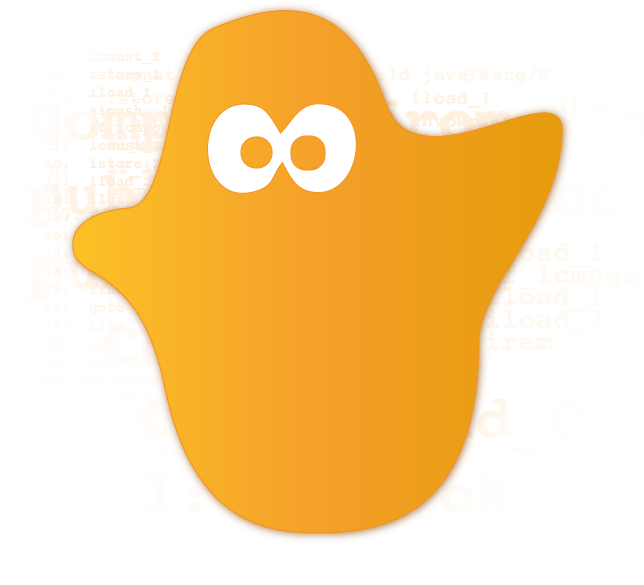
runtime code generation for the Java virtual machine
Byte Buddy is a code generation and manipulation library for creating and modifying Java classes during the runtime of a Java application and without the help of a compiler. Other than the code generation utilities that ship with the Java Class Library, Byte Buddy allows the creation of arbitrary classes and is not limited to implementing interfaces for the creation of runtime proxies. Furthermore, Byte Buddy offers a convenient API for changing classes either manually, using a Java agent or during a build.
In order to use Byte Buddy, one does not require an understanding of Java byte code or the class file format. In contrast, Byte Buddy’s API aims for code that is concise and easy to understand for everybody. Nevertheless, Byte Buddy remains fully customizable down to the possibility of defining custom byte code. Furthermore, the API was designed to be as non-intrusive as possible and as a result, Byte Buddy does not leave any trace in the classes that were created by it. For this reason, the generated classes can exist without requiring Byte Buddy on the class path. Because of this feature, Byte Buddy’s mascot was chosen to be a ghost.
Byte Buddy is written in Java 5 but supports the generation of classes for any Java version. Byte Buddy is a light-weight library and only depends on the visitor API of the Java byte code parser library ASM which does itself not require any further dependencies.
At first sight, runtime code generation can appear to be some sort of black magic that should be avoided and only few developers write applications that explicitly generate code during their runtime. However, this picture changes when creating libraries that need to interact with arbitrary code and types that are unknown at compile time. In this context, a library implementer must often choose between either requiring a user to implement library-proprietary interfaces or to generate code at runtime when the user’s types becomes first known to the library. Many known libraries such as for example Spring or Hibernate choose the latter approach which is popular among their users under the term of using Plain Old Java Objects. As a result, code generation has become an ubiquitous concept in the Java space. Byte Buddy is an attempt to innovate the runtime creation of Java types in order to provide a better tool set to those relying on code generation.

In October 2015, Byte Buddy was distinguished with a Duke's Choice award by Oracle. The award appreciates Byte Buddy for its "tremendous amount of innovation in Java Technology". We feel very honored for having received this award and want to thank all users and everybody else who helped making Byte Buddy the success it has become. We really appreciate it!
Byte Buddy offers excellent performance at production quality. It is stable and in use by distinguished frameworks and tools such as Mockito, Hibernate, Jackson, Google's Bazel build system and many others. Byte Buddy is also used by a large number of commercial products to great result. It is currently downloaded over 75 million times a year.
Saying Hello World with Byte Buddy is as easy as it can get. Any creation of a Java class starts with an instance
of the ByteBuddy class which represents a configuration for creating new types:
Class<?> dynamicType = new ByteBuddy()
.subclass(Object.class)
.method(ElementMatchers.named("toString"))
.intercept(FixedValue.value("Hello World!"))
.make()
.load(getClass().getClassLoader())
.getLoaded();
assertThat(dynamicType.newInstance().toString(), is("Hello World!"));The default ByteBuddy configuration which is used in the above example creates a Java class in the newest version of
the class file format that is understood by the processing Java virtual machine. As hopefully obvious from
the example code, the created type will extend the Object class and overrides its toString method which should
return a fixed value of Hello World!. The method to be overridden is identified by a so-called ElementMatcher. In
the above example, a predefined element matcher named(String) is used which identifies methods by their exact names.
Byte Buddy comes with numerous predefined and well-tested matchers which are collected in the ElementMatchers
class and which can be easily composed. The creation of custom matchers is however as simple as implementing the
(functional) ElementMatcher interface.
For implementing the toString method, the FixedValue class defines a constant return value for the overridden
method. Defining a constant value is only one example of many method interceptors that ship with Byte Buddy. By
implementing the Implementation interface, a method could however even be defined by custom byte code.
Finally, the described Java class is created and then loaded into the Java virtual machine. For this purpose, a target
class loader is required. Eventually, we can convince ourselves of the result by calling the toString method on an
instance of the created class and finding the return value to represent the constant value we expected.
Of course, a Hello World example is a too simple use case for evaluating the quality of a code generation library. In reality, a user of such a library wants to perform more complex manipulations, for example by introducing hooks into the execution path of a Java program. Using Byte Buddy, doing so is however equally simple. The following example gives a taste of how method calls can be intercepted.
Byte Buddy expresses dynamically defined method implementations by instances of the Implementation interface. In the
previous example, FixedValue that implements this interface was already demonstrated. By implementing this interface,
a user of Byte Buddy can go to the length of defining custom byte code for a method. Normally, it is however easier to
use Byte Buddy's predefined implementations such as MethodDelegation which allows for implementing any method in
plain Java. Using this implementation is straight forward as it operates by delegating the control flow to any POJO. As
an example of such a POJO, Byte Buddy can for example redirect a call to the only method of the following class:
public class GreetingInterceptor {
public Object greet(Object argument) {
return "Hello from " + argument;
}
}Note that the above GreetingInterceptor does not depend on any Byte Buddy type. This is good news because none of the classes
that Byte Buddy generates require Byte Buddy on the class path! Given the above GreetingInterceptor, we can use Byte Buddy
to implement the Java 8 java.util.function.Function interface and its abstract apply method:
Class<? extends java.util.function.Function> dynamicType = new ByteBuddy()
.subclass(java.util.function.Function.class)
.method(ElementMatchers.named("apply"))
.intercept(MethodDelegation.to(new GreetingInterceptor()))
.make()
.load(getClass().getClassLoader())
.getLoaded();
assertThat((String) dynamicType.newInstance().apply("Byte Buddy"), is("Hello from Byte Buddy"));Executing the above code, Byte Buddy implements Java's Function interface and implements the apply method
as a delegation to an instance of the GreetingInterceptor POJO that we defined before. Now, every time that the
Function::apply method is called, the control flow is dispatched to GreetingInterceptor::greet and the latter
method's return value is returned from the interface's method.
Interceptors can be defined to take with more generic inputs and outputs by annotating the interceptor's parameters. When Byte Buddy discovers an annotation, the library injects the dependency that the interceptor parameter requires. An example for a more general interceptor is the following class:
public class GeneralInterceptor {
@RuntimeType
public Object intercept(@AllArguments Object[] allArguments,
@Origin Method method) {
// intercept any method of any signature
}
}With the above interceptor, any intercepted method could be matched and processed. For example, when matching
Function::apply, the method's arguments would be passed as the single element of an array. Also, a Method
reference to Fuction::apply would be passed as the interceptor's second argument due to the @Origin
annotation. By declaring the @RuntimeType annotation on the method, Byte Buddy finally casts the returned
value to the return value of the intercepted method if this is necessary. In doing so, Byte Buddy also applies
automatic boxing and unboxing.
Besides the annotations that were already mentioned there exist plenty of other predefined annotations. For
example, when using the @SuperCall annotation on a Runnable or Callable type, Byte Buddy injects proxy
instances that allow for an invocation of a non-abstract super method if such a method exists. And even if
Byte Buddy does not cover a use case, Byte Buddy offers an extension mechanism for defining custom annotations.
You might expect that using these annotations ties your code to Byte Buddy. However, Java ignores annotations in case
that they are not visible to a class loader. This way, generated code can still exist without Byte Buddy! You can
find more information on the MethodDelegation and on all of its predefined annotations in its javadoc and in
Byte Buddy's tutorial.
Byte Buddy is not limited to creating subclasses but is also capable of redefining existing code. To do so, Byte Buddy offers a convenient API for defining so-called Java agents. Java agents are plain old Java programs that can be used to alter the code of an existing Java application during its runtime. As an example, we can use Byte Buddy to change methods to print their execution time. For this, we first define an interceptor similar to the interceptors in the previous examples:
public class TimingInterceptor {
@RuntimeType
public static Object intercept(@Origin Method method,
@SuperCall Callable<?> callable) {
long start = System.currentTimeMillis();
try {
return callable.call();
} finally {
System.out.println(method + " took " + (System.currentTimeMillis() - start));
}
}
}Using a Java agent, we can now apply this interceptor to all types that match an ElementMatcher for a TypeDescription. For the example, we choose to add the above interceptor to all types with a name that ends in Timed. This is done for the sake of simplicity whereas an annotation would probably be a more appropriate alternative to mark such classes for a production agent. Using Byte Buddy's AgentBuilder API, creating a Java agent is as easy as defining the following agent class:
public class TimerAgent {
public static void premain(String arguments,
Instrumentation instrumentation) {
new AgentBuilder.Default()
.type(ElementMatchers.nameEndsWith("Timed"))
.transform((builder, type, classLoader, module) ->
builder.method(ElementMatchers.any())
.intercept(MethodDelegation.to(TimingInterceptor.class))
).installOn(instrumentation);
}
}Similar to Java's main method, the premain method is the entry point to any Java agent from which we apply the redefinition. As one argument, a Java agent receives an instance of the Instrumentation interface which allows Byte Buddy to hook into the JVM's standard API for runtime class redefinition.
This program is packaged together with a manifest file with the Premain-Class attribute pointing to the TimerAgent. The resulting jar file can now be added to any Java application by setting -javaagent:timingagent.jar similar to adding a jar to the class path. With the agent active, all classes ending in Timed do now print their execution time to the console.
Byte Buddy is also capable of applying so-called runtime attachments by disabling class file format changes and using the Advice instrumentation. Please refer to the javadoc of the Advice and the AgentBuilder class for further information. Byte Buddy also offers the explicit change of Java classes via a ByteBuddy instance or by using the Byte Buddy Maven and Gradle plugins.
Byte Buddy is a comprehensive library and we only scratched the surface of Byte Buddy's capabilities. However, Byte Buddy aims for being easy to use by providing a domain-specific language for creating classes. Most runtime code generation can be done by writing readable code and without any knowledge of Java's class file format. If you want to learn more about Byte Buddy, you can find such a tutorial on Byte Buddy's web page (There is also a Chinese translation available).
Furthermore, Byte Buddy comes with a detailed in-code documentation and extensive test case coverage which can also serve as example code. Finally, you can find an up-to-date list of articles and presentations on Byte Buddy in the wiki. When using Byte Buddy, make also sure to read the following information on maintaining a project dependency.
The use of Byte Buddy is free and does not require the purchase of a license. To get the most out of the library or to secure an easy start, it is however possible to purchase training, development hours or support plans. Rates are dependent on the scope and duration of an engagement. Please get in touch with [email protected] for further information.
Sponsorship via GitHub is easy to set up and is available for different plans. For more information, visit the GitHub sponsors page of the author of the library.
Byte Buddy is listed on Tidelift. If you are not using Byte Buddy to an extent where you want to purchase explicit support and want to support the open source community in general, please consider a subscription.
General questions can be asked on Stack Overflow or on the Byte Buddy mailing list which also serve as an archive for questions. Of course, bug reports will be considered also outside of a commercial plan. For open source projects, it is sometimes possible to receive extended help for taking Byte Buddy into use.
Byte Buddy is written on top of ASM, a mature and well-tested library for reading and writing compiled Java classes. In order to allow for advanced type manipulations, Byte Buddy is intentionally exposing the ASM API to its users. Of course, the direct use of ASM remains fully optional and most users will most likely never require it. This choice was made such that a user of Byte Buddy is not restrained to its higher-level functionality but can implement custom implementations without a fuss when it is necessary.
ASM has previously changed its public API but added a mechanism for API compatibility starting with version 4 of the library. In order to avoid version conflicts with such older versions, Byte Buddy repackages the ASM dependency into its own namespace. If you want to use ASM directly, the byte-buddy-dep artifact offers a version of Byte Buddy with an explicit dependency to ASM. When doing so, you must repackage both Byte Buddy and ASM into your namespace to avoid version conflicts.
Byte Buddy is licensed under the liberal and business-friendly Apache Licence, Version 2.0 and is freely available on GitHub. Additionally, the byte-buddy distribution bundles ASM which is released under a 3-clause BSD license.
Byte Buddy binaries are published to the repositories of Maven Central and on JCenter. The artifacts signatures can be validated against this PGP public key beginning with Byte Buddy 1.10.3. Older versions can be validated against this older and weaker certificate.
The project is built using Maven. From your shell, cloning and building the project would go something like this:
git clone https://github.com/raphw/byte-buddy.git
cd byte-buddy
mvn packageOn these commands, Byte Buddy is cloned from GitHub and built on your machine. Further build options are listed in the root POM file. Byte Buddy is currently tested for versions 6 and upwards of the JDK on CI servers.
Please use GitHub's issue tracker for reporting bugs. When committing code, please provide test cases that prove the functionality of your features or that demonstrate a bug fix. Furthermore, make sure you are not breaking any existing test cases. If possible, please take the time to write some documentation. For feature requests or general feedback, you can also use the issue tracker or contact us on our mailing list.
The work on Byte Buddy is also possible thanks to a row of supporters that have dedicated regular resources and attention to the project. Please take your time to have a look at those supporters and their offerings.





